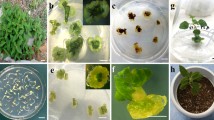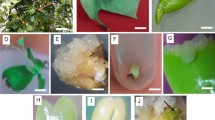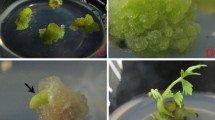Abstract
This study aims to establish an efficient protocol for protoplast isolation, cell division, and callus induction in two carnation cultivars, Chabaud and Giant Chabaud, by examining the influence of different types of plant tissue, enzyme concentrations, incubation times, cotyledon ages, and medium compositions. Our results indicate that protoplast yield varies significantly between different plant tissues, with true leaves offering the highest yield and viability, especially under a 0.1% driselase concentration and a 6-h incubation time. We observed that increasing the driselase concentration to 1.0% significantly reduced protoplast yields in all tissues tested. In addition, the age of the cotyledons notably affected protoplast yield, with younger cotyledons providing higher yields. The Murashige and Skoog medium supplemented with 1 mg/L zeatin and 1 mg/L 2,4-dichlorophenoxyacetic acid (2,4-D) proved to be the most effective for promoting cell division and colony formation from protoplasts derived from cotyledons and true leaves. The study also found that plant growth regulators (PGRs) significantly influence callus proliferation, with differences observed between protoplast sources.





Similar content being viewed by others
References
Adedeji OS, Naing AH, Kim CK (2020) Protoplast isolation and shoot regeneration from protoplast-derived calli of Chrysanthemum cv. White ND. Plant Cell Tissue Organ Cult (PCTOC) 141:571–581
Arai M, Sugawara Y, Matsushima H, Takeuchi M (1989) Enhancement of colony formation of carnation (Dianthus caryophyllus) mesophyll protoplasts by abscisic acid pretreatment. Plant Tissue Culture Letters 6(2):80–84
Cui J, Mackenzie KK, Eeckhaut T, Müller R, Lütken H (2019) Protoplast isolation and culture from Kalanchoë species: optimization of plant growth regulator concentration for efficient callus production. Plant Cell Tissue Organ Cult (PCTOC) 138(2):287–297
Duquenne B, Eeckhaut T, Werbrouck S, Van Huylenbroeck J (2007) Effect of enzyme concentrations on protoplast isolation and protoplast culture of Spathiphyllum and Anthurium. Plant Cell Tissue Organ Cult 91(2):165–173
Grzebelus E, Szklarczyk M, Baranski R (2012) An improved protocol for plant regeneration from leaf-and hypocotyl-derived protoplasts of carrot. Plant Cell. Tissue Organ Cult (PCTOC) 109:101–109
Jawaharlal M, Ganga M, Padmadevi K, Jegadeeswari V, Karthikeyan S (2009) A technical guide on carnation. A technical guide on carnation. Tamil Nadu Agricultural University, Coimbatore, pp 1–56
Jomori H, Takahata Y, Kaizuma N (1994) Plant regeneration from leaf-derived calli of gentians and their protoplast culture. Genetic Improv Hortic Crops Biotechnol 392:81–86
Kang HH, Naing AH, Kim CK (2020) Protoplast isolation and shoot regeneration from protoplast-derived callus of Petunia hybrida Cv. Mirage Rose. Biology 9(8):228
Kiełkowska A, Adamus A (2012) An alginate-layer technique for culture of Brassica oleracea L. protoplasts. In Vitro Cell Dev-Pl 48:265–273
Kim JC, Lee EA (1996) Plant regeneration from mesophyll protoplasts of Dianthus superbus. Plant Cell Rep 16(1):18–21
Meyer L, Serek M, Winkelmann T (2009) Protoplast isolation and plant regeneration of different genotypes of Petunia and Calibrachoa. Plant Cell, Tissue and Organ Cult (PCTOC) 99(1):27–34
Naing AH, Adedeji OS, Kim CK (2021) Protoplast technology in ornamental plants: current progress and potential applications on genetic improvement. Sci Hortic-Amst 283:110043
Nakano M, Mii M (1992) Protoplast culture and plant regeneration of several species in the genus Dianthus. Plant Cell Rep 11(5–6):225–228
Nakano M, Mii M (1995) Plant regeneration from protoplasts in Dianthus: comparison of cultural behavior of different donor tissues. Plant Tissue Culture Lett 12(1):62–67
Nakano M, Mii M, Genetics A (1993) Somatic hybridization between Dianthus chinensis and D. barbatus through protoplast fusion. Theoret Appl Genet 86(1):1–5
Nassour M, Chasseriaux G, Dorion N (2003) Optimization of protoplast-to-plant system for Pelargonium× hortorum ‘Alain’ and genetic stability of the regenerated plants. Plant Sci 165(1):121–128
Nhut DT, Teixeira Da Silva JA, Aswath CR (2003) The importance of the explant on regeneration in thin cell layer technology. In Vitro Cell Dev Biol Plant 39(3):266–276. https://doi.org/10.1079/IVP2002408
Nirmal Babu K, Samsudeen K, Divakaran M, Pillai GS, Sumathi V, Praveen K, Ravindran P, Peter K (2016) Protocols for in vitro propagation, conservation, synthetic seed production, embryo rescue, microrhizome production, molecular profiling, and genetic transformation in ginger (Zingiber officinale Roscoe.). In: Protocols for in vitro cultures and secondary metabolite analysis of aromatic and medicinal plants, Second Edition, pp 403–426
Nishihara M, Higuchi A, Watanabe A, Tasaki K (2018) Application of the CRISPR/Cas9 system for modification of flower color in Torenia fournieri. BMC Plant Biol 18(1):1–9
Pongchawee K, Na-Nakorn U, Lamseejan S, Poompuang S, Phansiri S (2006) Factors affecting the protoplast isolation and culture of Anubias nana Engler. To Bot 2:193–200
Rahmani M-S, Pijut PM, Shabanian N (2016) Protoplast isolation and genetically true-to-type plant regeneration from leaf-and callus-derived protoplasts of Albizia julibrissin. Plant Cell Tissue Organ Culture (PCTOC) 127(2):475–488
Reed KM, Bargmann BOR (2021) Protoplast regeneration and its use in new plant breeding technologies. Front Genome Edit 3:734951
Shiba T, Mii M (2005) Plant regeneration from mesophyll-and cell suspension-derived protoplasts of Dianthus acicularis and characterization of regenerated plants. In Vitro Cell Dev Biol-Plant 41:794–800
Xu J, Kang BC, Naing AH, Bae SJ, Kim JS, Kim H, Kim CK (2020) CRISPR/Cas9-mediated editing of 1-aminocyclopropane-1-carboxylate oxidase1 enhances Petunia flower longevity. Plant Biotechnol J 18(1):287–297
Xu J, Naing AH, Bunch H, Jeong J, Kim H, Kim CK (2021) Enhancement of the flower longevity of petunia by CRISPR/Cas9-mediated targeted editing of ethylene biosynthesis genes. Postharvest Biol Technol 174:111460
Xu J, Naing AH, Kang H, Lee SY, Li W, Chung MY, Kim CK (2023) CRISPR/Cas9-mediated editing of PhMLO1 confers powdery mildew resistance in petunia. Plant Biotechnol Rep 17(5):767–775
Funding
This work was supported by the National Research Foundation (NRF) grant funded by the Korean government (MSIT) (No. 2021R1A2C2008951).
Author information
Authors and Affiliations
Contributions
AHN designed the study. AOS conducted the experiments. JRC and KIP assisted with the experiments. AHN and AOS wrote the manuscript. CKK supervised the project. All authors read and approved the final manuscript.
Corresponding author
Ethics declarations
Conflict of interest
The authors report no conflicts of interest.
Additional information
Publisher's Note
Springer Nature remains neutral with regard to jurisdictional claims in published maps and institutional affiliations.
Rights and permissions
Springer Nature or its licensor (e.g. a society or other partner) holds exclusive rights to this article under a publishing agreement with the author(s) or other rightsholder(s); author self-archiving of the accepted manuscript version of this article is solely governed by the terms of such publishing agreement and applicable law.
About this article
Cite this article
Adedeji, O.S., Naing, A.H., Campol, J.R. et al. Influences of factors affecting the induction of high protoplast yield and callus induction in two different carnations. Plant Biotechnol Rep (2024). https://doi.org/10.1007/s11816-024-00903-7
Received:
Revised:
Accepted:
Published:
DOI: https://doi.org/10.1007/s11816-024-00903-7




